CHEVROLET TRACKER 1997 Owners Manual
Manufacturer: CHEVROLET, Model Year: 1997, Model line: TRACKER, Model: CHEVROLET TRACKER 1997Pages: 388, PDF Size: 20.12 MB
Page 121 of 388
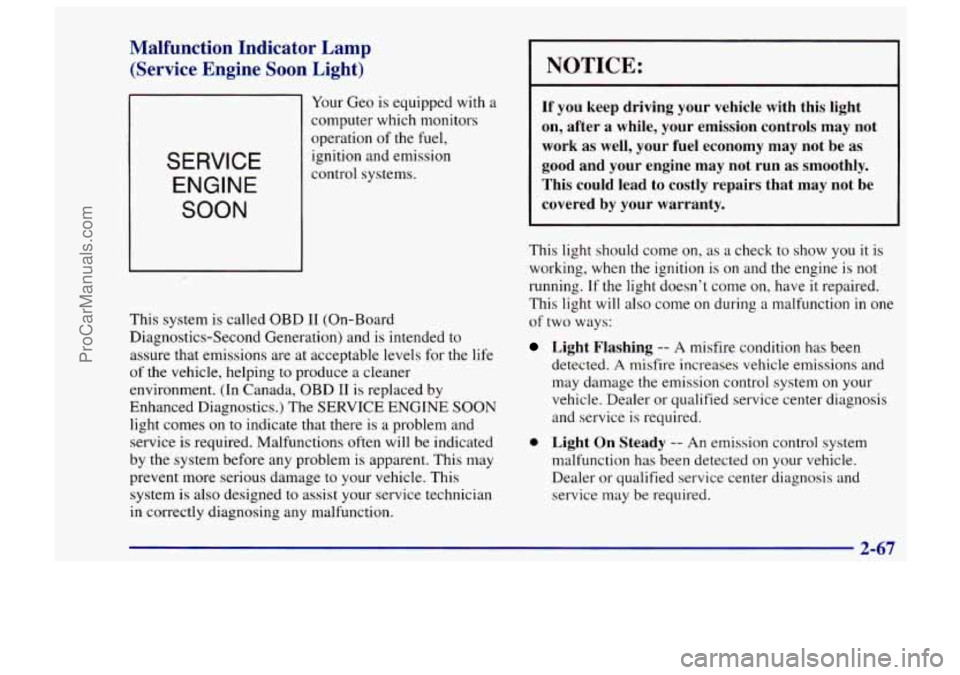
Malfunction Indicator Lamp (Service Engine
Soon Light)
SERVICE
ENGINE
SOON
Your Geo is equipped with a
computer which monitors
operation of the fuel,
ignition and emission
control systems.
This system is called OBD
I1 (On-Board
Diagnostics-Second Generation) and is intended to
assure that emissions are at acceptable levels for
the life
of the vehicle, helping to produce a cleaner
environment. (In Canada, OBD I1
is replaced by
Enhanced Diagnostics.) The SERVICE ENGINE
SOON
light comes on to indicate that there is a problem and
service is required. Malfunctions often will be indicated
by the system before any problem
is apparent. This may
prevent more serious damage to your vehicle. This
system
is also designed to assist your service technician
in correctly diagnosing any malfunction.
NOTICE:
If you keep driving your vehicle with this light
on, after a while, your emission controls may not
work as well, your fuel economy may not be as
good and your engine may not run as smoothly.
This could lead
to costly repairs that may not be
covered by your warranty.
This light should come on, as a check to show you it is
working, when the ignition is on and the engine is not
running.
If the light doesn’t come on, have it repaired.
This light
will also come on during a malfunction in one
of two ways:
Light Flashing -- A misfire condition has been
detected.
A misfire increases vehicle emissions and
may damage the emission control system on your
vehicle. Dealer
or qualified service center diagnosis
and service is required.
0 Light On Steady -- An emission control system
malfunction has been detected on your vehicle.
Dealer or qualified service center diagnosis and
service may be required.
m-w I
ProCarManuals.com
Page 122 of 388
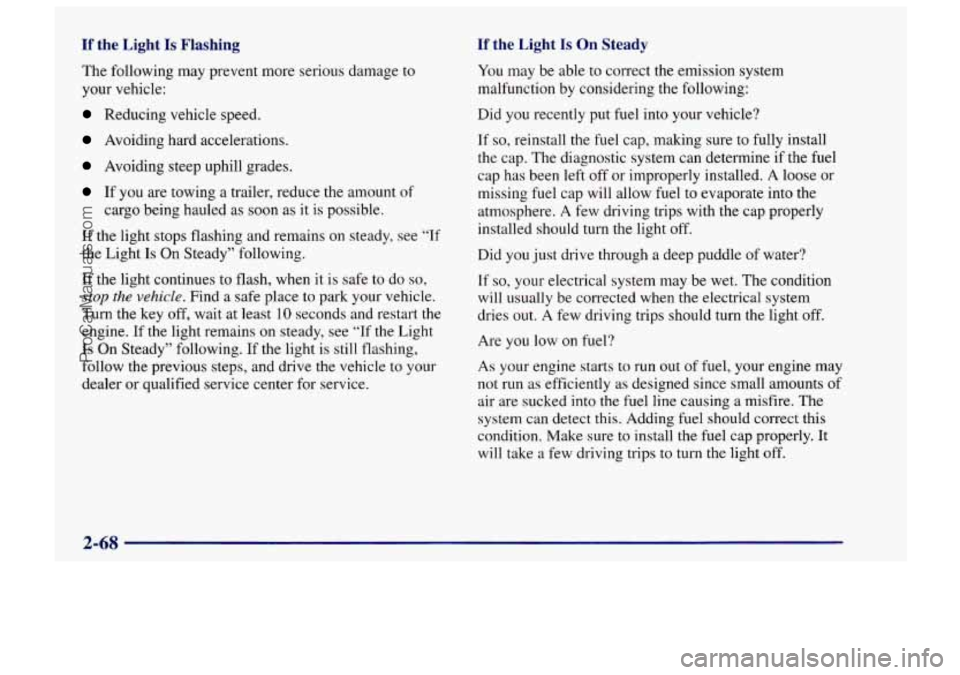
If the Light Is Flashing If the Light Is On Steady
The following may prevent more serious damage to
your vehicle:
Reducing vehicle speed.
Avoiding hard accelerations.
Avoiding steep uphill grades.
If you are towing a trailer, reduce the amount of
cargo being hauled as soon as it is possible.
If the light stops flashing and remains on steady, see
“If
the Light Is On Steady” following.
If the light continues to flash, when it
is safe to do so,
stop
the vehicle. Find a safe place to park your vehicle.
Turn the key off, wait at least
10 seconds and restart the
engine. If the light remains on steady, see “If the Light
Is On Steady” following.
If the light is still flashing,
follow the previous steps, and drive the vehicle to your
dealer
or qualified service center for service. You
may be able to correct the emission system
malfunction by considering the following:
Did you recently put fuel into your vehicle?
If so, reinstall the fL1el cap, making sure to fully install
the cap. The diagnostic system can determine
if the fuel
cap has been left off or improperly installed.
A loose or
missing fuel cap
will allow fuel to evaporate into the
atmosphere. A few driving trips with the cap properly
installed should
turn the light off.
Did you just drive through a deep puddle of water?
If so, your electrical system may be wet. The condition
will usually be corrected when the electrical system
dries out. A few driving trips should
turn the light off.
Are you low on fuel?
As your engine starts to run out of fuel, your engine may
not run
as efficiently as designed since small amounts of
air are sucked into the fuel
line causing a misfire. The
system can detect this. Adding fuel should correct this
condition. Make sure to install the fuel cap properly. It
will take a few driving trips to turn the light off.
ProCarManuals.com
Page 123 of 388
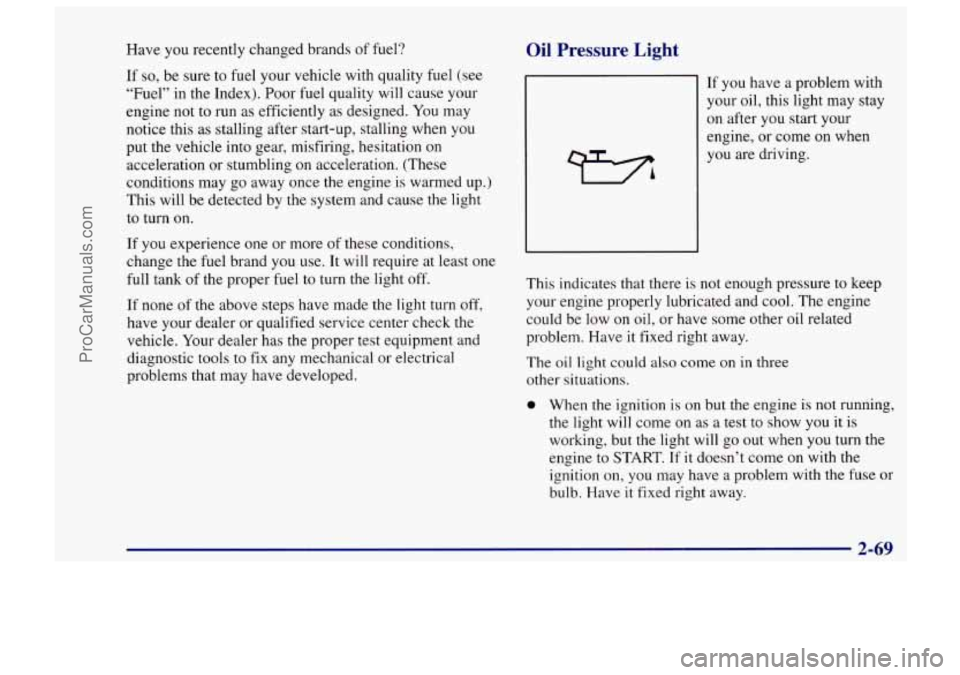
Have you recently changed brands of fuel?
If
so, be sure to fuel your vehicle with quality fuel (see
“Fuel” in the Index). Poor fuel quality will cause your
engine not to run as efficiently as designed.
You may
notice this as stalling after start-up, stalling when you
put the vehicle into gear, misfiring, hesitation on
acceleration or stumbling on acceleration. (These
conditions may go away once the engine is warmed up.)
This will be detected by the system and cause the light
to turn on.
If you experience one or more of these conditions,
change the fuel brand you use. It will require at least one
full tank of the proper fuel to turn the light off.
If none
of the above steps have made the light turn off,
have your dealer or qualified service center check the
vehicle.
Your dealer has the proper test equipment and
diagnostic tools to
fix any mechanical or electrical
problems that may have developed.
Oil Pressure Light
If you have a problem with
your oil, this light may stay
on after you start your
engine, or come on when
you are driving.
This indicates that there is not enough pressure to keep
your engine properly lubricated and cool. The engine
could be low on
oil, or have some other oil related
problem. Have
it fixed right away.
The
oil light could also come on in three
other situations.
0 When the ignition is on but the engine is not running,
the light will come on as a test to show you it
is
working, but the light will go out when you turn the
engine to START. If it doesn’t come on with the
ignition on, you may have a problem with the fuse or
bulb. Have it fixed right away.
2-69
I
ProCarManuals.com
Page 124 of 388
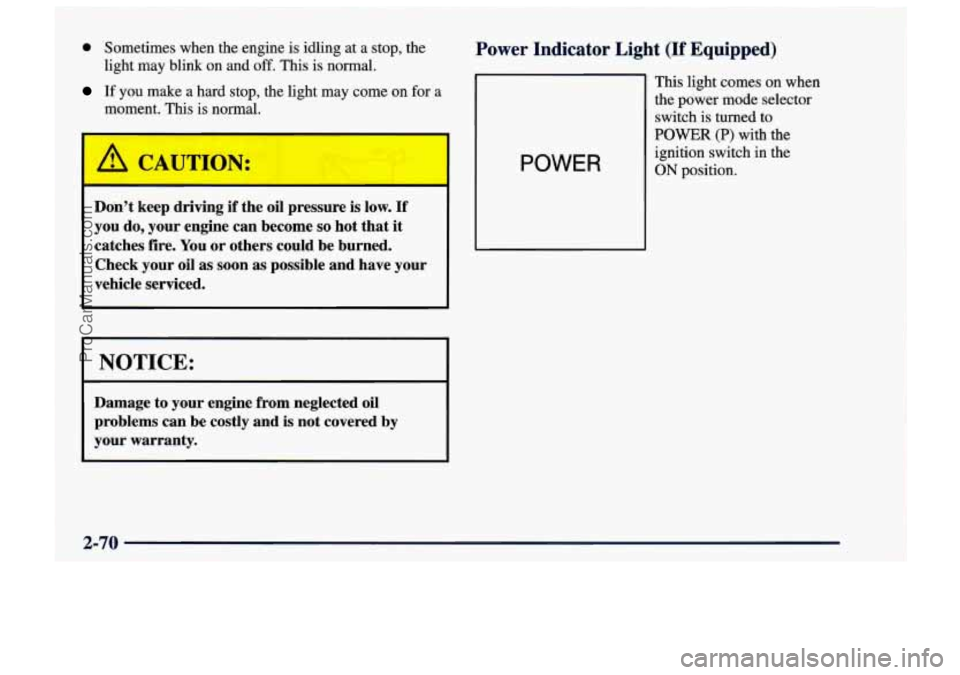
0 Sometimes when the engine is idling at a stop, the
light may blink on and
off. This is nonnal.
If you make a hard stop, the light may come on for a
moment. This is normal.
I I
A CAUTIPN:
I
Don't keep driving if the oil pressure is low. If
you do, your engine can become so hot that it
catches fie. You or others could be burned.
Check your oil as soon
as possible and have your
vehicle serviced.
NOTICE:
Damage to your engine from neglected oil
problems can be costly and is not covered by
your warranty.
Power Indicator Light (If Equipped)
POWER
This light comes on when
the power mode selector
switch
is turned to
POWER (P) with the
ignition switch in the
ON position.
2-70
ProCarManuals.com
Page 125 of 388
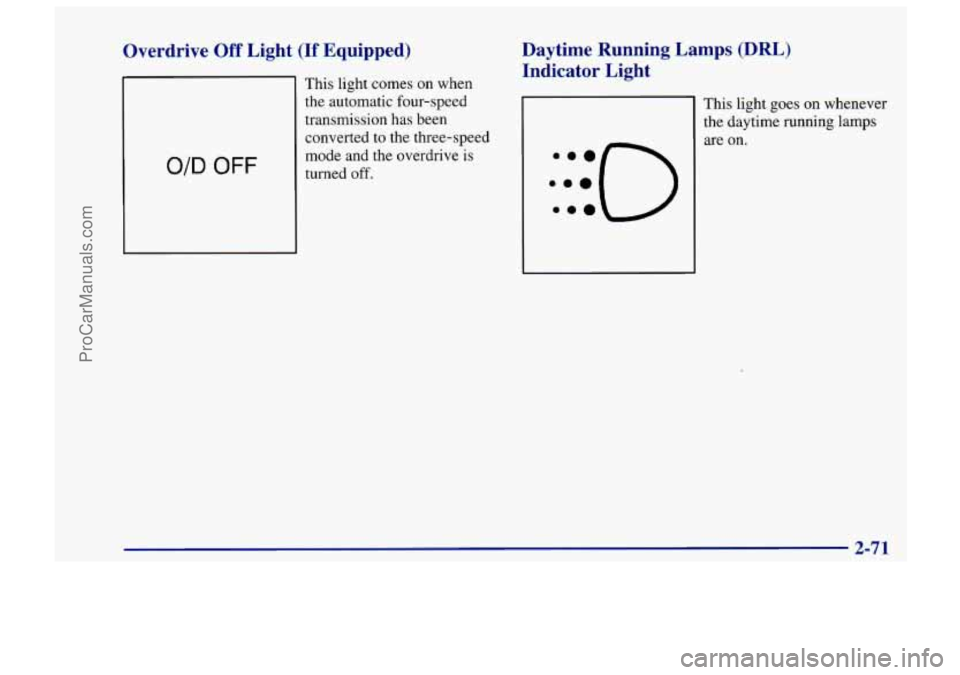
Overdrive Off Light (If Equipped)
O/D OFF
This light comes on when
the automatic four-speed
transmission has been
converted to the three-speed
mode and the overdrive
is
turned off.
Daytime Running Lamps (DRL)
Indicator Light
:::O .a.
This light goes on whenever
the daytime running lamps
are on.
ProCarManuals.com
Page 126 of 388
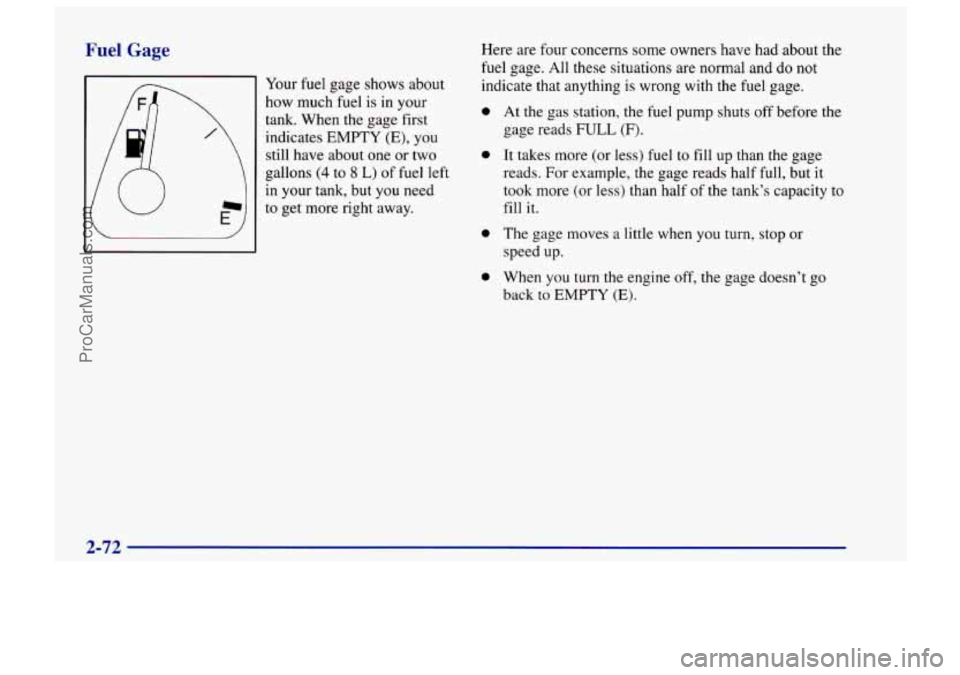
Fuel Gage
Your fuel gage shows about
how much fuel
is in your
tank. When the gage first
still have about one or two
gallons
(4 to 8 L) of fuel left
in your tank, but you need
to get more right away.
/ indicates EMPTY (E), you Here
are four concerns some owners have had about the
fuel gage. All these situations are normal and do not
indicate that anything
is wrong with the fuel gage.
0
0
0
0
At the gas station, the fuel pump shuts off before the
gage reads
FULL (F).
It takes more (or less) fuel to fill up than the gage
reads.
For example, the gage reads half full, but it
took more (or less) than half
of the tank’s capacity to
fill
it.
The gage moves a little when you turn, stop or
speed up.
When you turn the engine off, the gage doesn’t
go
back to EMPTY (E).
ProCarManuals.com
Page 127 of 388
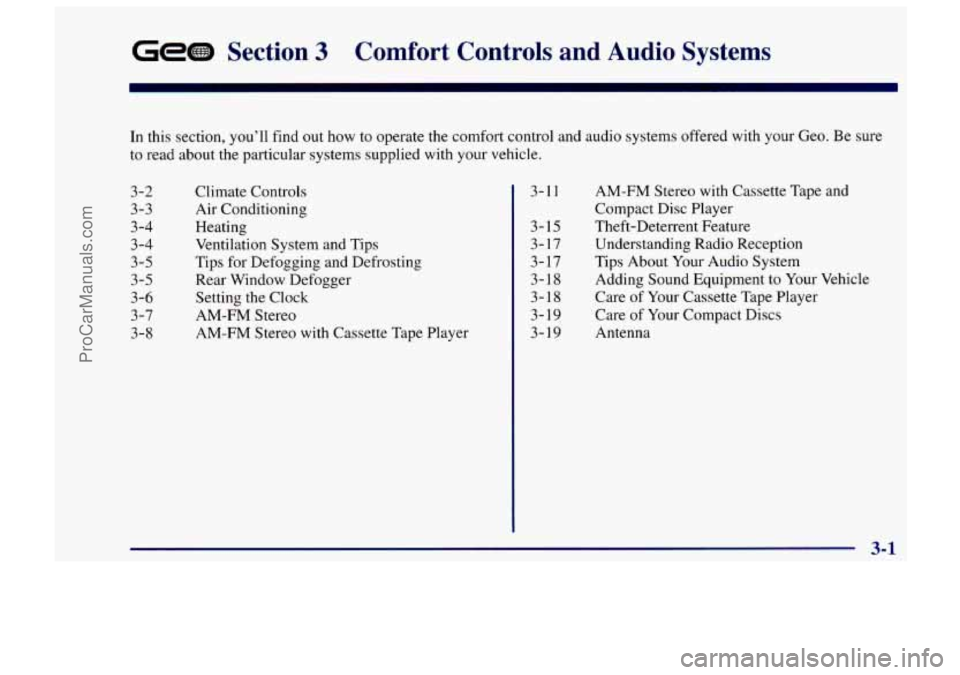
Section 3 Comfort Controls and Audio Systems
In this section, you’ll find out how to operate the comfort control and audio systems offered with your Geo. Be sure
to read about the particular systems supplied with your
. v-e. ..
3-2 Climate Controls 3-1 1
3-3 Air
Conditioning
3-4 Heating
3-18
3-5 Rear Window Defogger 3-
17
3-5 Tips for Defogging and Defrosting 3-17
3-4 Ventilation System and Tips 3-
15
3-6 Setting the
Clock
3-19
3-8 AM-FM Stereo with Cassette Tape Player 3-
19
3
-7 AM-FM Stereo 3-18 AM-FM
Stereo with Cassette Tape and
Compact Disc Player
Theft-Deterrent Feature Understanding Radio Reception
Tips About Your Audio System
Adding Sound Equipment to Your Vehicle
Care of Your Cassette Tape Player
Care of Your Compact Discs
Antenna
3-1
ProCarManuals.com
Page 128 of 388
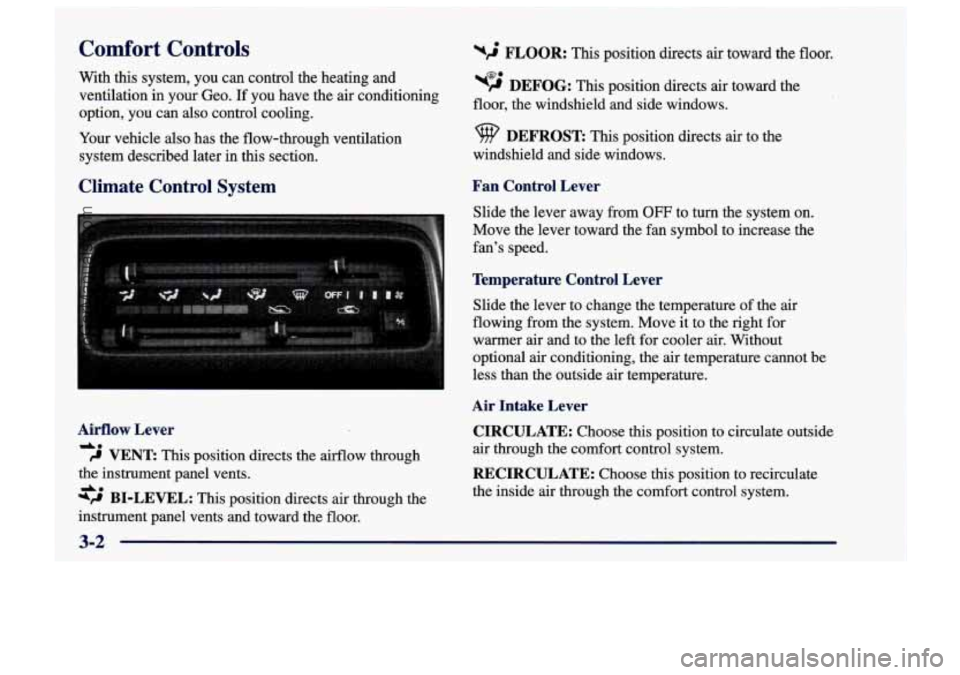
Comfort Controls
With this system, you can control the heating and
ventilation in your Geo.
If you have the air conditioning
option, you can also control cooling.
Your vehicle also has the flow-through ventilation
system described later in this section.
Climate Control System
Airflow Lever
de
9 VENT This position directs the airflow through
the instrument panel vents.
49 BI-LEVEL: This position directs air through the
instrument panel vents and toward the floor.
A.
%$ FLOOR: This position directs air toward the floor.
w> DEFOG: This position directs air toward the
floor, the windshield and side windows.
9 DEFROST This position directs air to the
windshield and side windows.
Fan Control Lever
Slide the lever away from OFF to turn the system on.
Move the lever toward the fan symbol to increase the
fan’s speed.
Temperature Control Lever
Slide the lever to change the temperature of the air
flowing from the system. Move it to the right for
warmer air and to the left for cooler
air. Without
optional air conditioning, the
air temperature cannot be
less than the outside air temperature.
Air Intake Lever
CIRCULATE:
Choose this position to circulate outside
air through the comfort control system.
RECIRCULATE: Choose this position to recirculate
the inside
air through the comfort control system.
3-2
ProCarManuals.com
Page 129 of 388
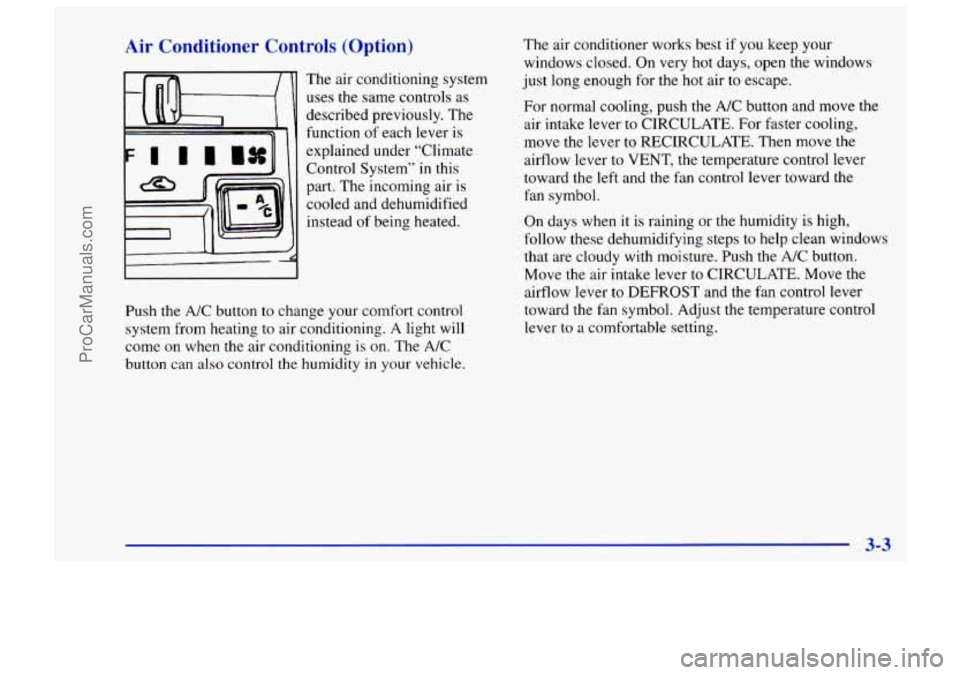
Air Conditioner Controls (Option)
The air conditioning system
uses the same controls as
described previously. The
function
of each lever is
explained under “Climate
Control System” in this
part. The incoming air is
cooled and dehumidified
instead of being heated.
Push the
A/C button to change your comfort control
system from heating to air conditioning.
A light will
come
on when the air conditioning is on. The A/C
button can also control the humidity in your vehicle.
The air conditioner works best if you keep your
windows closed. On very hot days, open the windows
just long enough for the hot air to escape.
For normal cooling, push the
A/C button and move the
air intake lever to CIRCULATE. For faster cooling,
move the lever to RECIRCULATE. Then move the
airflow lever to VENT, the temperature control lever
toward the left and the fan control lever toward the
fan symbol.
On days when
it is raining or the humidity is high,
follow these dehumidifying steps to help clean windows
that are cloudy with moisture. Push the A/C button.
Move the air intake lever to CIRCULATE. Move the
airflow lever to DEFROST and
the fan control lever
toward the fan symbol. Adjust
the temperature control
lever to
a comfortable setting.
3-3
ProCarManuals.com
Page 130 of 388
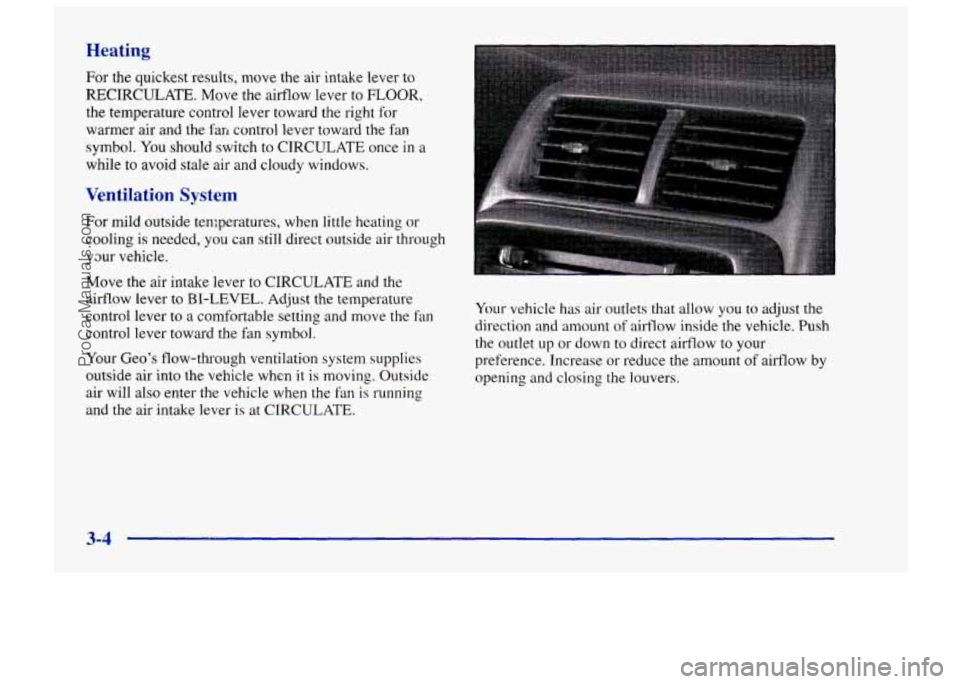
Heating
For the quickest results, move the air intake lever to
RECIRCULATE. Move the airflow lever to FLOOR,
the temperature control lever toward the right for
warmer air and the
far, control lever toward the fan
symbol.
You should switch to CIRCULATE once in a
while to avoid stale air and cloudy windows.
Ventilation System
For mild outside temperatures, when little heating or
cooling is needed, you can still direct outside air through
ymr vehicle.
Move the air intake lever to CIRCULATE and the
airflow lever
to BI-LEVEL. Adjust the temperature
control lever to
a comfortable setting and move the fan
control lever toward the fan symbol.
Your Geo’s flow-through ventilation system supplies
outside air into the vehicle when
it is moving. Outside
air will also enter the vehicle when the fan is running
and the air intake lever is at CIRCULATE. Your
vehicle has air outlets that allow you to adjust the
direction and amount
of airflow inside the vehicle. Push
the outlet
up or down to direct airflow to your
preference. Increase or reduce the amount
of airflow by
opening and closing the louvers.
3-4
ProCarManuals.com